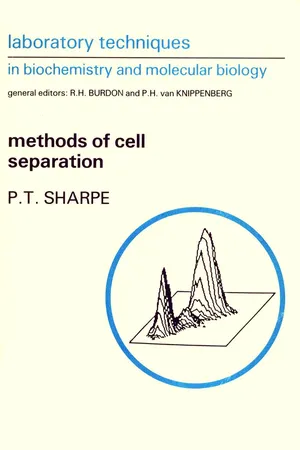Methods of Cell Separation
About this book
Methods of Cell Separation brings to the attention of researchers at all levels the variety of methods available for separating viable populations of cells. Methods are grouped into 3 categories based on the criteria of separation, namely; size or density; non-specific surface properties; and specific surface properties. The principle of each method is described together with general and, where possible, specific protocols for conducting cell separation experiments.A central theme of the book is the separation of populations of blood lymphocytes which is used as an example for each method.Methods of Cell Separation is distinguished by three powerful assets: descriptions of the majority of cell separation methods currently being used; details of the experimental procedures involved in each method; and comparisons of the different methods for separating cell populations with particular reference to blood lymphocytes.An excellent addition to a distinguished series, and extremely useful as a laboratory manual.
Frequently asked questions
- Essential is ideal for learners and professionals who enjoy exploring a wide range of subjects. Access the Essential Library with 800,000+ trusted titles and best-sellers across business, personal growth, and the humanities. Includes unlimited reading time and Standard Read Aloud voice.
- Complete: Perfect for advanced learners and researchers needing full, unrestricted access. Unlock 1.4M+ books across hundreds of subjects, including academic and specialized titles. The Complete Plan also includes advanced features like Premium Read Aloud and Research Assistant.
Please note we cannot support devices running on iOS 13 and Android 7 or earlier. Learn more about using the app.
Information
Table of contents
- Front Cover
- Methods of Cell Separation
- Copyright Page
- Contents
- Abbreviations
- Chapter 1. Introduction
- Chapter 2. Methods of cell counting and assaying cell viability
- Chapter 3. Centrifugation
- Chapter 4. Unit gravity sedimentation
- Chapter 5. Centrifugal elutriation
- Chapter 6. Aqueous two-phase partition
- Chapter 7. Electrophoresis
- Specific surface methods – an introduction to Chapters 8–13
- Chapter 8. Affinity chromatography
- Chapter 9. Affinity separation on fibres and surfaces
- Chapter 10. Affinity partition
- Chapter 11. Flow sorting
- Chapter 12. Magnetic cell sorting
- Chapter 13. Separation of cells in different phases of the cell cycle
- Appendix
- References
- General references for further reading
- Subject index
